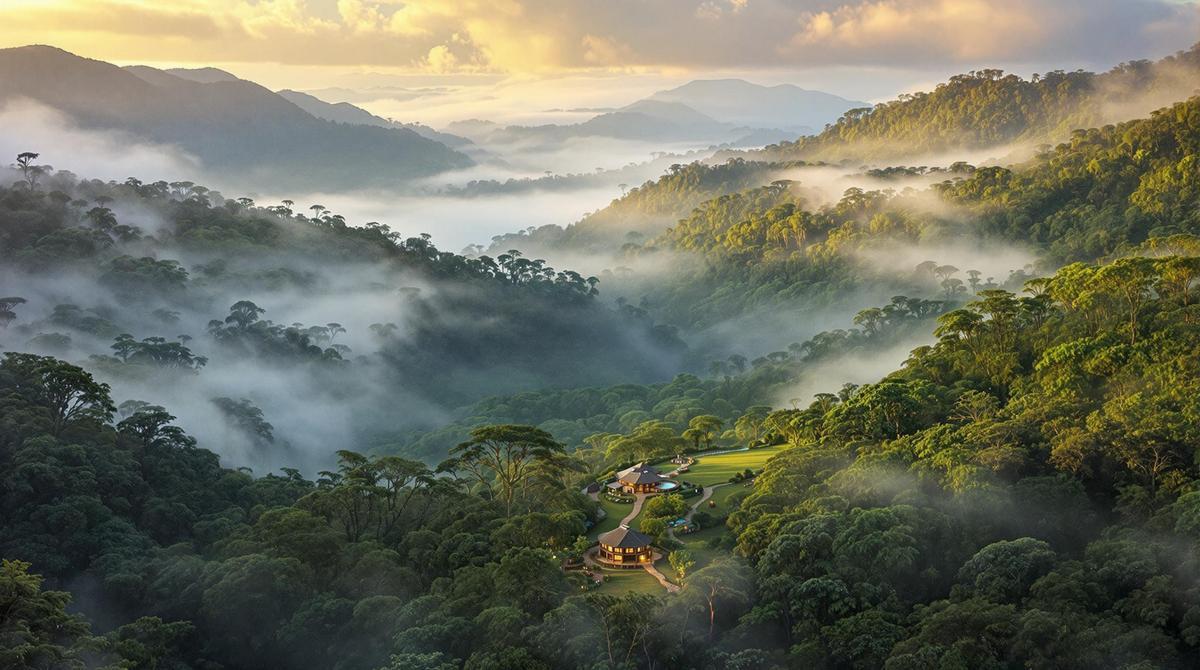Kenya’s wilderness holds many secrets, but none quite as magical as the misty, mountainous realm that sits beyond the typical safari circuit. The Aberdare National Park rises dramatically from the central highlands, creating a world where elephants roam through bamboo forests and waterfalls thunder through primeval rainforests. This 766-square-kilometer sanctuary isn’t just another wildlife reserve—it’s where a young Princess Elizabeth learned she had become Queen of England while staying at the famous Treetops Hotel in 1952.
A mountain wilderness like no other
Unlike Kenya’s savanna parks, Aberdare captivates with its dramatic elevation changes, ranging from 2,000 to 4,000 meters above sea level. This creates distinct ecological zones packed with unique wildlife adapted to high-altitude living. The Kikuyu people who have lived in the shadows of these mountains for centuries call them “Nyandarua”—meaning “drying hide”—because of their distinctive silhouette resembling an animal skin pegged out to dry in the sun.
The remarkable tree hotels that changed African tourism
Perhaps the most distinctive feature of Aberdare is its legendary tree hotels. The Ark and Treetops offer a wildlife viewing experience unlike anywhere else—elevated wooden structures where guests can watch elephants, buffalo, and even elusive leopards visit watering holes below their rooms throughout the night. These architectural marvels blend seamlessly with their surroundings, allowing visitors to witness wildlife behaviors rarely seen during daylight hours.
“There’s something primally thrilling about watching a herd of elephants silently appear from the forest at midnight while you’re safely tucked away in your tree-level room,” says Peter Mbugua, a veteran Aberdare guide. “It’s a connection to nature most people never experience.”
The misty kingdom of black leopards
Aberdare harbors one of Africa’s most elusive creatures—the melanistic leopard, better known as the black panther. The park’s thick forests and misty conditions have created an environment where this rare genetic variation thrives. Though extremely difficult to spot, these shadowy cats represent the holy grail for wildlife photographers who visit Kenya, much like those who explore unique crater lakes in other parts of the world.
Spectacular waterfalls hidden in pristine forests
The park boasts some of East Africa’s most impressive waterfalls, including the three-tiered Karuru Falls plunging 273 meters into a misty gorge. These cascades create pockets of microclimate that support unique plant species, including rare orchids and giant heather trees draped in old man’s beard lichen. The hiking trails to these falls offer explorers an experience reminiscent of journeying through hidden limestone canyons in distant lands.
A freedom fighter’s last refuge
Beyond wildlife, the park holds significant historical importance as the hiding place of Dedan Kimathi, leader of the Mau Mau rebellion against British colonial rule in the 1950s. The dense forests provided cover for freedom fighters, with caves and natural fortresses serving as command centers. Today, visitors can learn about this pivotal chapter in Kenya’s struggle for independence while exploring the same landscapes.
Where endangered species find sanctuary
The park provides critical habitat for threatened species including the mountain bongo—one of Africa’s rarest and most beautiful antelopes. With less than 100 remaining in the wild, these striped forest dwellers represent the conservation importance of Aberdare. The protected ecosystem also sustains significant populations of endangered black rhinos, showcasing Kenya’s commitment to preservation much like wilderness areas in the Mediterranean.
“The Aberdare mountains are a living museum of Kenya’s natural heritage,” explains Dr. Margaret Waweru, conservation biologist. “The unique climate and isolation have created a biological island where species have adapted in fascinating ways.”
Beyond the Big Five
While many visit Kenya seeking the famous Big Five, Aberdare offers encounters with less-celebrated but equally fascinating creatures like the giant forest hog, colobus monkeys, and the elusive golden cat. The park’s 250+ bird species include the endemic Aberdare cisticola and the brilliantly colored Hartlaub’s turaco, making it a paradise for birdwatchers seeking experiences comparable to cultural experiences in historic Asian villages.
Tips for the intrepid explorer
Visit during January, February, June or September for optimal weather conditions. Pack warm clothing—temperatures drop dramatically at night in this high-elevation park. For the ultimate experience, split your stay between a tree hotel and a mountain lodge to experience both forest and moorland ecosystems. Consider adding a cultural visit to nearby villages where traditional Kikuyu life continues much like in heritage-rich coastal communities elsewhere.
In Aberdare, the misty mountains reveal their secrets slowly to those willing to venture beyond the expected African safari. Here, in this highland wilderness, Kenya offers a profound connection to both the natural world and human history—a reminder that some places still hold mysteries worth discovering firsthand.
